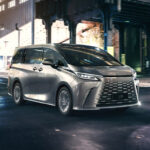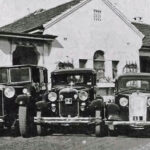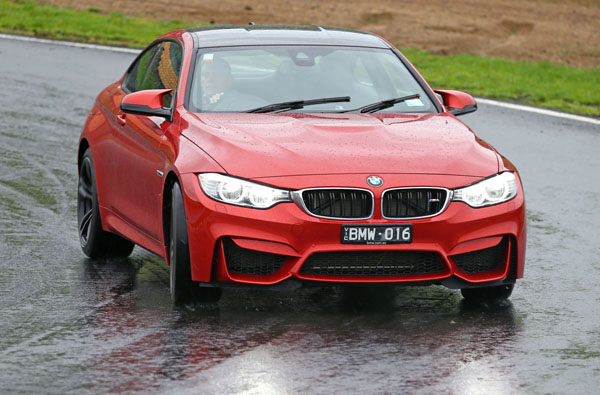
Last week we reviewed the latest BMW M3 sedan that we tested on both road and track in New Zealand. This time it’s the turn of its two-door hardtop sibling, the M4 coupe, launched alongside the sedan and replacing the previous M3 coupe.
As the ‘M’ prefix suggests the M4 is the high-performance version of the new 4 Series which arrived in Australia in late 2013 and which extended BMW’s even-number naming format where the sportier two-door variants of the 1, 3 and 5 Series cars were renamed as the 2, 4 and 6 Series.
Name changes can be risky but performance car buyers know their stuff and will be well aware that the M4 is the latest evolution of the M3 coupe with its reputation as one of the world’s great driving cars and are unlikely to be put off by the new badge.
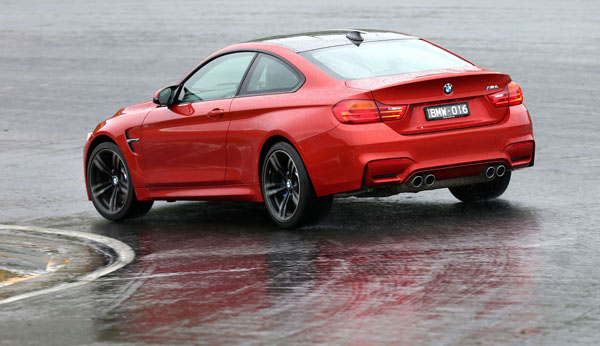
STYLING
Our American cousins got the first look at the M4 coupe, initially in concept form at the 2013 Pebble Beach Concours d’Elegance with the production model being unveiled at the 2014 Detroit Auto Show.
Apart from the obvious difference of the doors the M4 coupe is all-but identical to the M3 sedan. The two cars share the same length and wheelbase measurements with the coupe being fractionally narrower and 41 mm lower to provide a lower-slung look than the sedan. The coupe’s doors are longer to provide easier access to the two rear seats (the sedan has three) and the rear spoiler is integrated into the boot lid rather than fitted as in the sedan.
The characteristic BMW long, nicely sculpted, bonnet is broken by the usual power dome in the rear-centre. At the rear of the bonnet are twin heat exhausts.
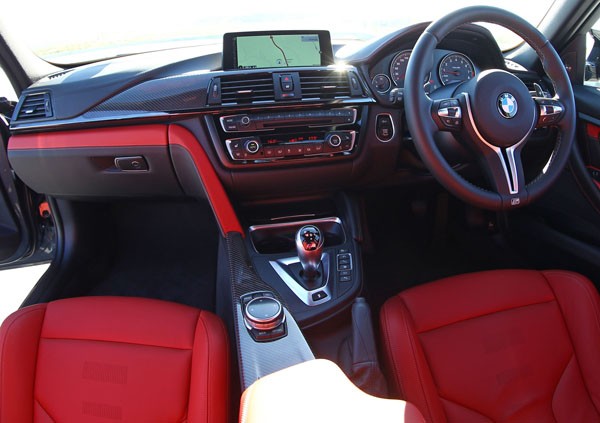
As with the previous M3 coupe the standard roof on the M4 is made from lightweight carbon-fibre reinforced plastic (CFRP) and comes in black providing an eye-catching contrast to the various body colours. A glass sunroof is available as a no-cost option but negates some of the CFRP weight saving.
INTERIOR
Access to the M4’s rear seats through the front doors is reasonably easy although those looking for a weekday family commuter / weekend fun car are far more likely to choose the M3 with its extra doors and larger rear seat.
Rear legroom with the front seats fully extended is negligible while headroom, although 40 mm less than in the sedan, will be acceptable for passengers under about 1.9 metres.
The sports seats are firm but comfortable and adjustable side bolsters that can make a major difference to the driving enjoyment of the ample-buttocked.
The M4 loses 35 litres of boot space compared to the M3 although, at 445 litres, there’s enough space for a decent amount of holiday luggage.
ENGINE / TRANSMISSION
After experimenting with V8 power in the previous (fourth) generation M3, BMW has reverted to a straight-six engine for the new M3 and M4. This time however it comes with a pair of turbochargers that help it generate 317 kW of power and 550 Nm of torque from the 3.0-litre engine. That’s well above the output from both the 3.2-litre six of the third generation M3 coupe as well as the 4.0-litre V8 of the just superseded model (309 kW and 400 Nm).
Through the wonders of turbocharging these higher outputs are reached with less fuel – the new M4 uses just 8.3 litres per 100 kilometres on the combined cycle, compared to the 10.5 L/100 km of the previous six and the 11.9 of the V8.
Transmission options are seven-speed M double-clutch automatic or an upgraded six-speed manual, the latter available only on special order and at the same price as the automatic.
SAFETY
As expected from a car of this quality BMW M4 comes with the latest standard safety equipment including six airbags, enhanced braking systems and dynamic stability control.
However with an rrp of $166,900 there are still many features within a longish option list including Lane Change and Blind Spot Warning ($1000), Head-Up Display ($1700), Tyre Pressure Warning ($550) and Parking Assistant ($675).
The BMW Connected Drive includes Intelligent Emergency Call which transmits vehicle crash information to a BMW Call Centre from where emergency service are alerted if required. Similarly, TeleServices which transmit breakdown information.
INFOTAINMENT
BMW M4 comes with all of the latest features based around a high-resolution 8.8-inch colour display including satellite navigation; 16-speaker Harman Kardon surround sound; digital radio; DVD drive; on-board computer with 20 Gb hard drive; USB and Auxiliary sockets; and Bluetooth phone and audio streaming.
DRIVING
The Australasian launch of the M4 was held in New Zealand alongside the M3 with the ability to switch back and forwards between the cars both on the two racetracks (Hampton Downs and Taupo) and on the 250 kilometres of delightful road between the two tracks.
The M4 is 23 kg lighter than the M3 and around 60 kg less than the previous M3 coupe.
With the assistance of launch control the zero to 100 km/h acceleration from both M3 and M4 is 4.1 seconds with the automatic transmission and 4.3 seconds with the manual. Acceleration is almost instant with the twin turbos combining to eliminate any sign of turbo lag.
The steering (now electro-mechanical), suspension and engine each have a choice of three settings which really add to the driving enjoyment.
The brain says the sound of an engine shouldn’t matter but the heart says it does and that may be one factor that could influence potential buyers. During its seven years on the local market M3 owners came to love the V8 burble from under the bonnet. While the new twin-turbo does have its own distinctive sound but there’s something artificial about it. Time will tell whether this affects sales.
SUMMING UP
Some BMW purists will no doubt be muttering at the company for bringing in the new naming (numbering) format which has taken away the iconic M3 name from the coupe which started it all and given exclusive rights to the Johnny-come-lately sedan. Others will no doubt bemoan the loss of the V8 engine.
One test drive and they’ll get over it because, with the most power and torque to date and the lowest fuel consumption and emissions, the new M4 is quite simply the best M3 yet.
NEWS
MITSUBISHI MIRAGE SEDAN IS A BIG SMALL CAR
By EWAN KENNEDY
CAPTION: Styling of the rear of the all-new Mitsubishi Mirage sedan is tidy and hides a huge boot.
BODY COPY
Mitsubishi has taken an interesting route with the all-new sedan version of its Mirage hatch. This isn’t simply the same body with a different rump, it has been stretched by 100 mm in its wheelbase to greatly increase legroom in the back seat. To the extent that it can seat four adults with ease. I’m a six-footer in the old money and can sit comfortably in the back with the driver’s seat in my normal position.
The industry statistician, Vfacts, has therefore moved the Mirage sedan into the next size category up (officially it’s a Light Car, not a Micro Car, though I’ve yet to hear a member of the public using these terms when asking me about cars…)
Mitsubishi Mirage totally dominates its market category with year-to-date sales of Mirage hatch that are almost as high as the total of the other eight cars in the class combined.
Interestingly, Toyota took the same tack with its Corolla sedan late last year. The Corolla sedan is also significantly bigger than the hatch, which has noticeably increased sales.
There’s a message here: Australian car buyers are happy to move to smaller cars, but demand useful interior room.
Speaking of which, the Mirage sedan has a very large boot capacity at 450 litres. However the back seat can’t be folded so versatility isn’t as good as it should have been.
Two sedan models are offered. Even the lower cost one, the Mirage ES, has alloy wheels, air conditioning and full connectivity that includes Bluetooth. It’s priced at $14,990 with the manual and $16,490 as an auto. On-road costs aren’t included in these prices.
The Mirage LS only comes with the automatic transmission and is priced at $17,490. It gains keyless entry and start, automatic lights and wipers, a leather trimmed steering wheel, tinted side glass, a slightly more upmarket trim and some added chrome details.
Power for the Mirage sedan comes from the same 1.2-litre three-cylinder engine as the hatch. With 57 kW of power and 100 Nm of torque it’s no ball of fire. At this stage we’ve only been able to do a short road test, and that on level roads. It performed fine there, but we will have to reserve judgement till we carry our or normal full week’s review.
Transmission is by five-speed manual or CVT automatic.
Our brief drive showed surprisingly low levels of interior noise for this class. Considerable work has gone into achieving sound reduction and the latest Mirage hatches have also received this NVH minimisation treatment. We will try and get hold of a hatch for an update on its road test.
Mirage sedan and hatch have a five-year, 100,000 kilometre warranty. Capped price servicing applies to the first four services. The rrp is $299 for each, the schedule is 15,000 km or 12 months, whichever comes first.




